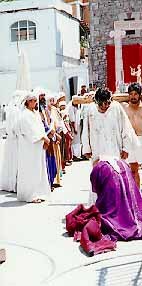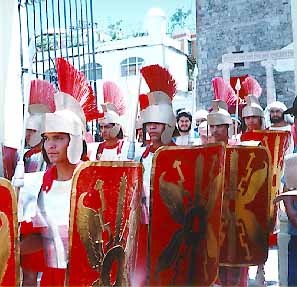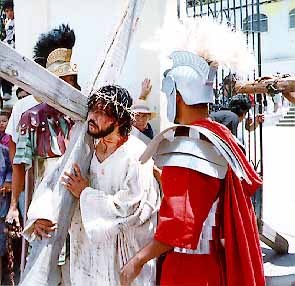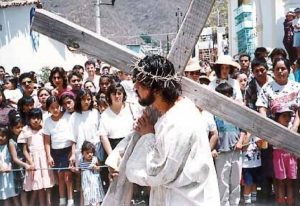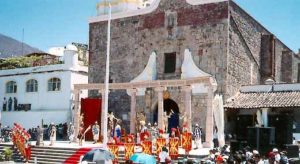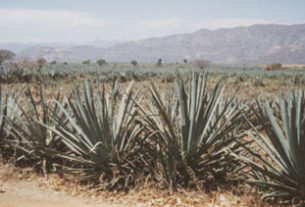It should come as no surprise that in Mexico, a predominantly Roman Catholic country, Easter — Pascua — is the most widely celebrated and important religious holiday of the year. Observances that would be of interest to visitors from abroad may be witnessed in virtually every village, town and city in the Republic beginning with Domingo de Ramos (Palm Sunday — this year April 17, 2011)) and ending Domingo de Gloria (Easter Sunday — April 24). Although each and every community boasts unique traditions for celebrating Semana Santa (Holy Week), in most locales you are likely to see some or all of the following:
Blessing of the Palms
Semana Santa gets underway on Palm Sunday when the faithful may join in a special mass which includes the blessing of palm fronds or crosses and other figures that have been fashioned from palms. A large procession commemorating Jesus’ triumphal entry into Jerusalem often precedes the mass. Some of the blessed palms are later burned and the ashes reserved by the church for marking the sign of the cross on the foreheads of communicants during Ash Wednesday services the following year.
Vespers of Darkness
On Wednesday of Holy Week, some churches celebrate a late-afternoon vespers service called “los matines de las tinieblas”, in which the disciples’ abandonment of Jesus is recalled. A candelabra set with 15 candles illuminates the altar. One candle is extinguished after the singing of each Psalm until, at the end of the service, only the center candle, representing the Lord Jesus, remains lit.
Maundy Thursday — Observances Begin
The commemoration of Easter begins in earnest on this day, Jueves Santo. In cathedrals throughout the country, the bishops celebrate special masses during which the Chrism, a sacred oil used in the sacraments, is consecrated. In the evening many churches hold some type of re-enactment of the Last Supper. During Masses on this day the customary exchange of greetings of peace is omitted from the liturgy, a reminder of Judas’ betrayal of Jesus. It is also customary to silence the church bells during the Triduo Pascual, the three key days of the Easter holiday.
Good Friday — The Passion of Jesus
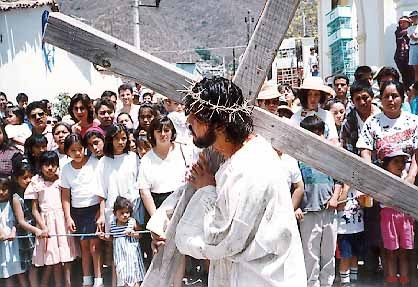
In many towns and villages the trial and crucifixion of Jesus Christ is remembered through a Passion Play, or a recreation of the Via Crucis, (the Way of the Cross) on Viernes Santo — Holy Friday. This may be an all-day event involving a cast of hundreds of amateur performers playing key roles in the Biblical story, that reaches its climax with a simulated crucifixion. In other places there may be some type of solemn procession in which most of the populace participates as penitents. In addition, the Virgin Mary´s pain and suffering at the loss of her son may be recalled with the display of an Altar de Dolores–an Altar of Sorrows.
Holy Saturday — The Solemn Vigil
The greatest of the holy vigils celebrated during the liturgical year is the day between Good Friday and Easter Sunday. Frequently this includes a solemn evening mass during which each communicant lights a candle at the altar, holding it throughout the remainder of the ceremony. Following mass, participants may gather outside the church for some comic relief with the raucous burning of Los Judas. These large papier maché effigies, usually painted in eye-popping colors, represent Judas Iscariot and other forces of evil, including the devil and unpopular political personalities. Especially prepared by the local “cohetero” who creates fireworks for all festive occasions, the figures are hung up in the street or the central town plaza. Once the public has gathered, they are ignited in quick succession and, to the delight of all, are literally blown to bits, thereby symbolizing the triumph of good over evil, which Christ’s Resurrection represents.
Easter Sunday — Domingo de Gloria
For Christian churches, this is unquestionably the most important day of the entire year. Since all Roman Catholics are expected to attend mass and take Holy Communion to mark the holiday, every celebration held in each of the thousands of churches throughout Mexico will be packed with celebrants on this day. It is a unique time for spirtual renewal, born of the hope promised by the Resurrection of Jesus Christ. The church bells will once again peal, now with especially joyous fervor. With church attendance at a high, you can also expect to see plenty of festive crowds bustling about every town plaza following the services, including the ubiquitous street vendors hawking tacos, ice cream and other snacks. There will also be balloons and toys, perhaps even mechanical rides, for the enjoyment of the youngsters.
No Bunny, No Jelly Beans — A Nation on Vacation
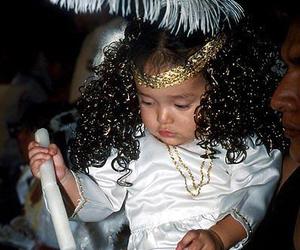
What you won’t see in Mexico at Easter time, except perhaps in giant urban supermarkets, will be any sign of the Easter Bunny. No jelly beans, marshmallow chickens, cellophane grass, Easter baskets or colored eggs either. These are strictly Gringo customs that, despite NAFTA, have so far, failed to make it across the border.
On the other hand, what you will find is an entire nation on vacation. While students north of the border take a Spring Break holiday scheduled at some random time in March or April, nearly everyone in Mexico is granted time off from work or school during Holy Week. Mexican schools are generally closed for the entire two-week period comprising Semana Santa and Semana de Pascua–Holy Week and Easter Week. Many employees are also allowed one or two weeks vacation time at Easter. From Maundy Thursday through Easter Sunday you’ll find most government offices and banks close their doors and, with the exception of those who work in the tourist industry, virtually all workers are granted time off.
What all this means to unknowing visitors from abroad, is that it is practically impossible to encounter lodging in, or transportation to and from, any major resort or tourist destination. Last-minute bookings or changes in airline reservations can be tricky. Expect to find air, train and bus terminals jammed with harried travelers. Major highways throughout the country will register the greatest flow of traffic during this holiday period. And even the nation’s most isolated beach destinations are likely to be completely overtaken by large families of campers and day-trippers. This is, however, a fairly good time to enjoy a visit to the largest urban areas such as Mexico City, Monterrey and Guadalajara, where the massive desertion of city residents translates into less traffic and a substantial reduction in normal levels of air pollution.
Interesting Easter Destinations
Of the fascinating traditional Easter observances celebrated in Mexico, many originated during the time of the Spanish Conquest or the early Colonial period, when live representations and dramatizations were widely used for the instruction of Christian doctrine. Many of them also have roots in the Pre-Columbian era, demonstrating the synthesis of indigenous and European cultures so unique to Mexico.
Among the most colorful Easter events in the nation are the series of processions held throughout Semana Santa in Taxco, Gro., the Holy Week Processions of Silence in San Luis Potosi , S.L.P. and San Miguel de Allende, Gto., and the Passion Plays of Ajijic, Jalisco and Ixtapalapa in Mexico City.
Other destinations offering celebrations of interest: Patzcuaro and Tzintzuntzan, Michoacan; Queretero, Que.; Huajcori and Mesa de Nayar, Nayarit; Creel, Cusarare and San Ignacio Arareco, Chih. ; Jerez, Zac.; Atlixco, Pue.; Temascalcingo, Mex.; and San Juan Chamula and Zinacantan, Chis.
(A free-lance writer and Spanish-English translator, Dale Hoyt Palfrey has made her home in Ajijic, Mexico since 1973. Her Mexico-Connection, however, goes back to the early 1950’s when her grandparents were among the first wave of foreign retirees in the Lake Chapala area. She has observed that newcomers who adapt successfully to living in Mexico tend to take an active interest in understanding the country’s people, language and cultural.)

